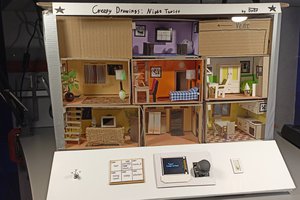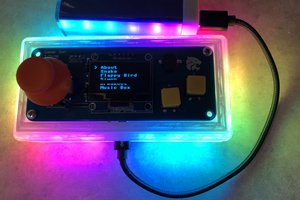The game is called Blind Whackamole because it requires that a player presses all the buttons they are supposed to, but they don't know which are the right buttons and they must be told by someone else. It's a forced collaborative game. To beat it requires 3 people, because the number of buttons pressed simultaneously and the width of the playing board means that more than two hands are required.
The rules are simple; one side of the game has numbers that light up. The other side has numbered buttons. When all the buttons that correspond to lighted numbers are held down, the level is complete. If the right button is being pressed it turns from blue to green to give feedback to the person calling out the numbers. If a wrong button is pressed it lights up red. As the game progresses through levels, the number of buttons to press at once increases. If the timer runs out before the buttons are all held down, then the level resets with new numbers. Once enough levels are complete, the display freezes and shows three numbers, which are used as the start of the next puzzle.
The game starts by requiring two coins are inserted into slots. I picked two because I wanted to make sure that users would find the other side of the game board. Also, at the beginning the lights flash randomly because if I didn't draw at least some current then the battery pack would shut itself off after some time, and I didn't want the game to shut itself off.
Here is a video of gameplay for the first few levels (before I needed a second hand). You can see what happens when the teams get the right answer, run out of time, or press the wrong buttons.
The coins had a hole drilled and wire attached so they wouldn't get lost. When they are inserted a small cardboard piece contains it, and a limit switch is wired to detect the insertion. That starts the game. At each level it displays a number on the numbered strip, and the vertical light strip starts counting down. When the correct input is entered the display lights up green, then flashes a display that shows the number of completed levels and the total number of levels. This was to show the users that they were making progress and not to give up, though in practice few people noticed it or figured out what it was for. After flashing the level status, it would then move to the next level and show more numbers. If the time ran out, it would flash red, then the current level progress, then restart the level. At first I had it drop back a level, but that just led to frustration, especially at the end of the game.
The board is made with foam-core paper board used for science fair presentations and stuff. It's a nice material to work with for quick and simple structures. It's held together with tape mostly. I didn't need it to be super sturdy or last a long time. There are three strips of aluminum extrusion from Amazon specifically made for LED light strips. They were left over from another project. Inside two of them were WS2812 strips. Inside the third was a series of momentary push buttons wired individually (it was a fat bundle). Everything went back to the main project box, which was scavenged from a set of dremel bits or some development kits; I don't even remember, but they were plastic boxes that were perfect.
The numbers were done by printing off on regular paper, then cutting out long paper strips, and using spray adhesive on the front, then sticking it to the underside of the plastic extruded channel. Pretty simple.
The hardware is a custom PCB that contains 1 ATTiny that has a single output for the WS2812 strip (one strip goes through the section for the numbers, then the enclosure strip, then the timer strip, with a wire connecting the three strips DO to DI. The other part of the circuit board is a pair of analog mux's 74HC4067. This way I could have up to 32 analog inputs piped into a single ATTiny. Originally I had planned to use photoresistors...
Read more » Bob Baddeley
Bob Baddeley

 Danya0x07
Danya0x07

 Brian Wagner
Brian Wagner
 iSax
iSax
Very cool game idea. This could be turned into a kids' educational toy so easily.
(Thinking about this, why are non-educational toys meant to play with friends, while educational ones are always for playing alone?)
There is a half-million dollar idea here.